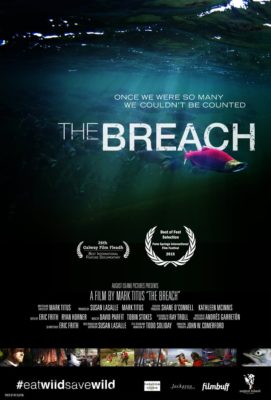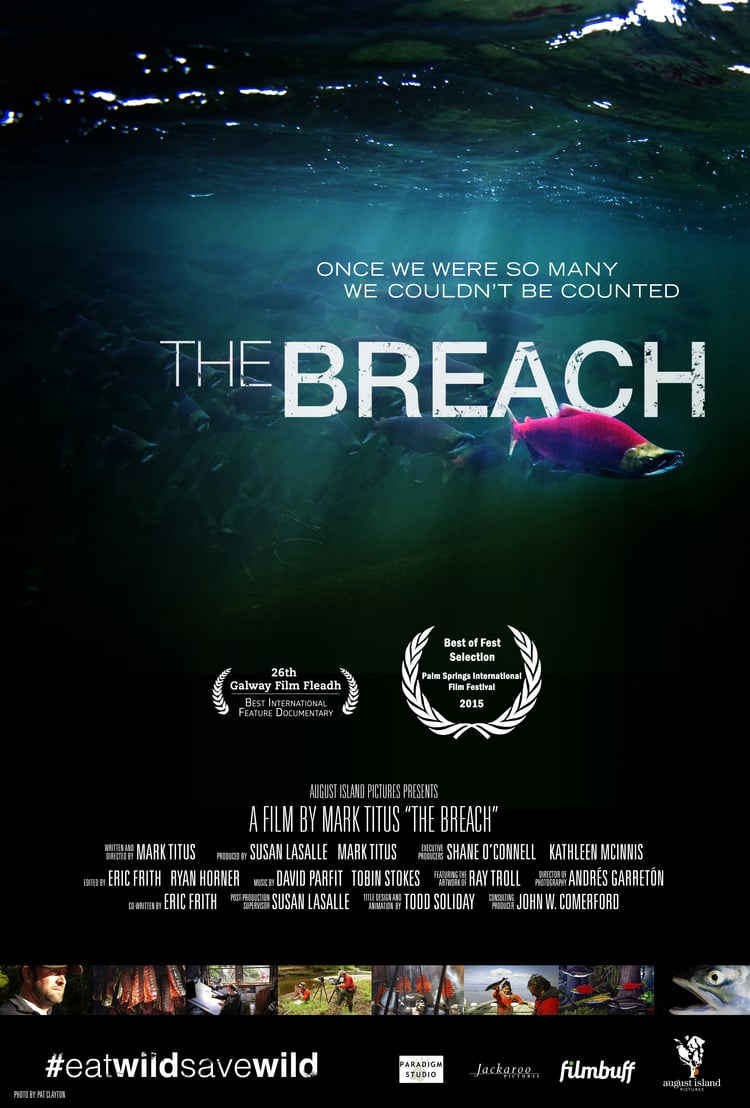When I sat down to watch “The Breach”, directed by Mark Titus, I had no idea how relevant and uncannily timely this 2015 documentary would be.

Release Year: 2015
Running Time: 82 min
Director: Mark Titus
Watch the trailer
Titus was inspired to make this film after a lifetime in which wild salmon had held a central role.
He grew up fishing, catching his first salmon with the aid of his father at age two, then spent most of his 20s leading fishing tours in Alaska.
After reading a book chronicling some of the challenges facing wild salmon, he was inspired to share what he had learned through “The Breach.”
I, too, grew up around salmon, as I suppose many folks from the Pacific Northwest have, and was surprised by how much I didn’t know when watching the film.
I was born and raised in Pullman, on the Snake River. School field trips took me to the fish ladder at Lower Granite Lock and Dam, and a salmon hatchery in Idaho that was a culmination of a whole unit we did on salmon in seventh grade.
Concerns about salmon habitat were always in the background of political and environmental discussion, but never pierced my consciousness as a seriously critical issue. Talk about salmon was ubiquitous, and salmon seemed to be ever-present, that I thought it couldn’t possibly be that much of a problem.
I was wrong.
“The Breach” takes us from Montana through Idaho, Oregon, and Washington, up to Canada, and finally to Alaska. Along the way we learn about the five types of Pacific Salmon (another detail I never paid much attention to before) and the uniquely genius — but delicate — lifecycle of salmon.
The life of a salmon begins in a creek bed where its mother laid hundreds of eggs. When it has developed enough that it is ready to transition from freshwater to saltwater, it starts its journey down stream towards the Pacific Ocean.
In the ocean it will feed and grow until it is time for it to return back up the very same river, through the tributaries to the small stream were it was initially hatched. There it will spawn, and die.
Along its journey, and even after it has died, the salmon feeds many other animals and plants. Steven Hawley, author of “Recovering a Lost River” and featured in the film discussing the cleanup of Johnson Creek in Portland, notes that one hundred and thirty-seven different creatures depend on salmon in one way or another.
Bruce Brown, author of “Mountain in the Clouds,” the book that first awakened director Titus to the issues facing salmon, explains that all the rain we get in the Pacific Northwest strips nutrients from the land and runs it into the water.
Salmon collect all these nutrients when they’re in the ocean feeding, and then bring them back when they come back to spawn.
“They are the principal way that nature returns nutrients to the land,” says Brown.
Dr. Carol Ann Woody likens rivers and tributaries to capillaries in bodies, distributing nutrients throughout the ecosystem.
One large challenge to this complex lifecycle is the dams along rivers that prevent salmon from getting back up to their spawning grounds.
The film looks specifically at the long fight to remove two dams on the Elwha River. The effort started in 1976, and was the beginning of the larger movement for dam removal throughout the Pacific Northwest.
The river that I grew up on, the Snake, is the largest tributary of the Columbia. It has four dams, actively blocking thousands of miles of healthy salmon habitat upriver in Washington and Idaho.
Before fish can even get up to the Snake, they face four dams on the Columbia itself. At every one of these eight dams, salmon die on their way out to the Pacific and struggling to get up to their native streams on the trip back.
One “solution” to the problems of diminished salmon population, partially due to dams, is hatcheries. These fish are raised in captivity until they’re old enough to be released. But then hatchery and wild fish compete for food and habitats. Hatchery fish can also weaken the gene pool if they interbreed with wild fish.
Another danger to wild Pacific salmon is the practice of farming Atlantic salmon in net pens.
“Every single migration route for wild salmon is now blocked by these feedlots,” says biologist Alexandra Morton, who first came to the Broughton Archipelago in Canada in 1984 to study whales.
But audio devices that the fish farms installed in the 1990s to scare whales away from their pens were so effective that whales have never returned. Morgan then switched the focus of her research and activism to salmon and net pen farms.
These large net pens are essentially like feedlots which exist on land for pigs and cattle, but are in the open water, where they pose multiple risks for native salmon. The Atlantic salmon contained in the pens can harbor diseases, such as sea lice, which are then passed on to the Pacific salmon passing by in the open water.
Waste from these fish also piles up underneath the net pens, damaging the seabed underneath. The biggest risk of all is the possibility that these non-native Atlantic salmon (which are foreign to Pacific waters), could wreak havoc on the marine ecosystem of Cascadia were they to escape the net pens.
There have been small escapes before, but just over two months ago there was a complete collapse of a net pen in Washington waters, releasing 160,000 Atlantic salmon near Cypress Island in the San Juans, where native Pacific salmon pass by on their way back to rivers to spawn. Any interference with the migration of our native species could have disastrous consequences for species that are struggling to increase their population to a more stable and sustainable level.
If the Atlantic salmon are carrying disease, the breach could be even more catastrophic. Native American tribes and other fisherman have been working hard since the escape to catch as many of the escaped fish as possible, but about 100,000 are still unaccounted for and making their way to rivers across the region.
As NPI Vice President and former Alaskan salmon fisher Diane Jones wrote in September, we must make changes to better protect our native salmon. A good start would be not allowing any new net pens or the restocking of ones currently in our waters; even better would be banning them entirely, as Alaska and California do, and cancelling contract and permits for those currently in operation.
If this incident wasn’t bad enough news for wild Pacific salmon, just last month it was reported that Trump’s head of the EPA withdrew an Obama-era proposal to protect an area in Alaska’s Bristol Bay that is at risk of serious ecological damage from a proposed copper mine project.
The decision, handed down in May, was announced just hours after the CEO of Pebble Limited Partnership, the mining company, met with the EPA.
The story of Bristol Bay and the threats posed by the proposed Pebble Mine are also emphasized prominently in “The Breach.”
Bristol Bay is home to one of the last healthy salmon fisheries in the world. The habitat there is mostly undisturbed and unpolluted.
This is primarily due to the fact that salmon are protected as a resource in the Alaska State Constitution, so fishing must be done responsibly and sustainably.
Over one half of the sockeye salmon in the world come from the Bristol Bay fishery. The fishery is home to 14,000 jobs a year and adds $1.5 billion to the economy. There’s also a fair amount of sport fishing, and a large population of subsistence fishers, many of whom are Native American.
Salmon have been an integral part of the lives and cultures of many Native American tribes for untold generations, and Bristol Bay is one of the few places where that key part of their livelihood and heritage has remained relatively intact.
The Bristol Bay fishery and all that it contributes and represents is now at risk if this proposed copper mine were to be greenlit and constructed.
The proposed open pit mine would be over three miles wide and 4,000 feet deep, located in the headwaters of Bristol Bay salmon country. Over ninety-four miles of streams would be lost, as they would be used in mine operations.
There is a high likelihood that sulfuric acid and metals from the mine could get into the waterways, which would have consequences for many local species, not just salmon. Copper above certain levels is toxic to salmon, destroying their sense of smell. A salmon’s sense of smell is critical, as it is their smell that leads them back to their home rivers and streams where they spawn.
The mining company claims that they can safely contain the “pond” of tailings behind a dam (the term pond is used loosely, as it would be massive).
However, there have been multiple failures of tailings dams in the last few years, including one that was designed by the same people who designed the proposed Pebble Mine tailings dam. The dam at the Pebble Mine would be six times taller than the one that failed in British Columbia.
The toxic material from the mines must be stored in perpetuity, yet in British Columbia and New Guinea, tailings dam failures occurred after only a few years. These facts make it hard to believe that Pebble can safely contain the toxic materials forever, and the eternal risk of failure or leakage, and the damage it will cause to Bristol Bay and all the species that inhabit it, are not worth whatever amount of copper would be extracted from the mine.
The Breach teaches us that salmon fisheries are a fragile resource facing many dangers. It’s up to us to put this knowledge to work to save our wild salmon.
What can do we do? What actions can we take to make a difference?
First, don’t buy farmed Atlantic salmon.
Second, contact Governor Jay Inslee, Commissioner of Public Lands Hillary Franz, and your representatives in the Washington State Legislature to let them know you support a complete ban of Atlantic salmon farming in Washington.
Third, support the United Tribes of Bristol Bay, the Alaska Wilderness League, and allied organizations fighting the Pebble Mine project in Alaska.
And finally, as probably goes without saying, speak out against the Trump regime’s assault on our planet at every turn, and demand that important decisions impacting the environment be made based not on politics or profit, but on science.

